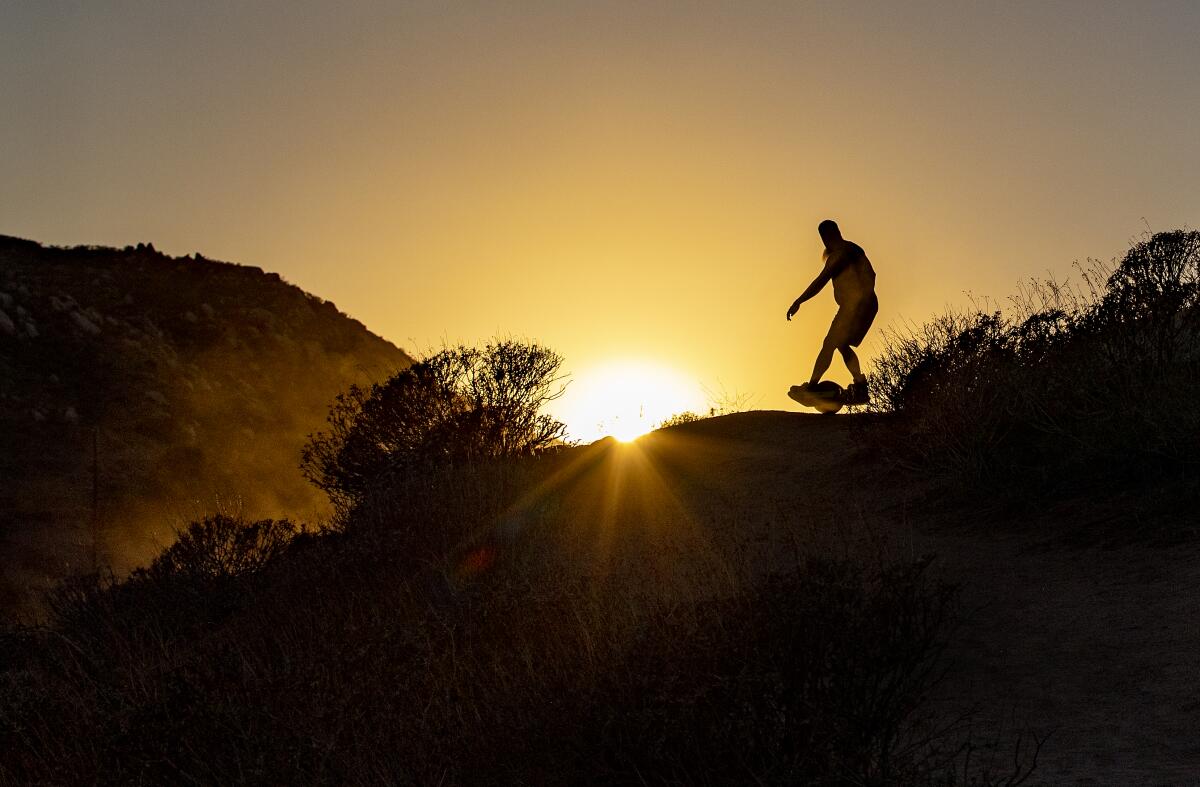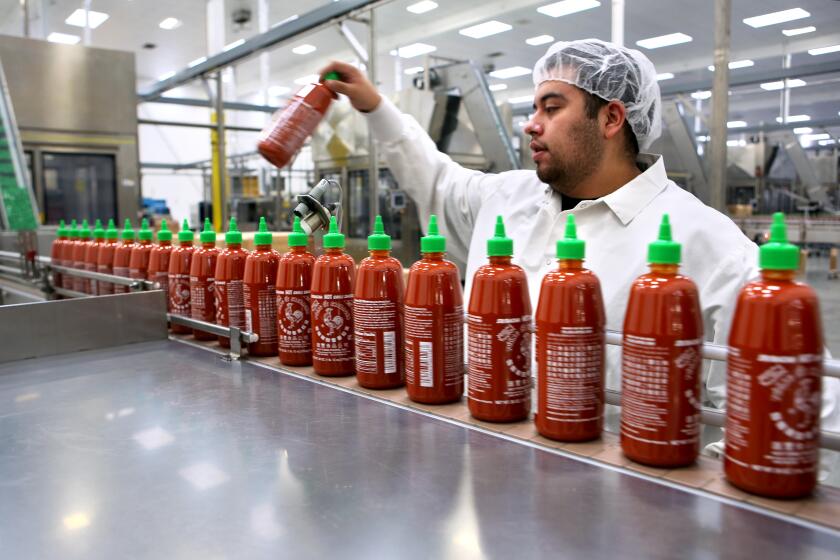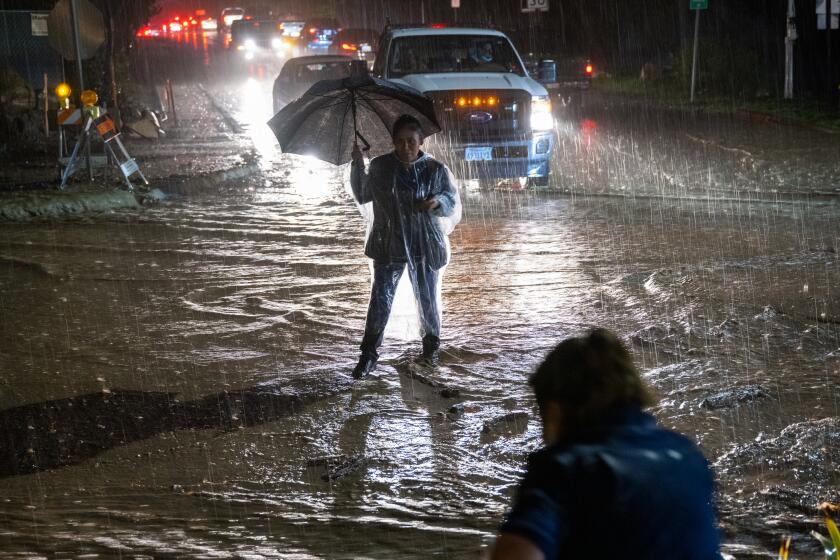Triple-digit heat wave set to sizzle California, stoking fire fears this holiday weekend

- Share via
Much of California is expected to bake this weekend as the first major heat wave of the summer will send temperatures into the triple digits in several regions, stoking fears of wildfires sparked by Fourth of July festivities.
The incoming system will arrive in Southern California on Wednesday evening, and the mercury will begin to climb in earnest Thursday and into next week, the National Weather Service said. The hottest temperatures are expected across interior portions of the region Saturday and Sunday.
In those areas, daytime temperatures are predicted to reach the high 90s and low 100s in the desert, lower mountains and interior valleys. The warmest portions of Los Angeles County valleys could see 100 degrees by Saturday, while the interior valleys of San Luis Obispo County and the Antelope Valley could climb to 107.
The sizzling conditions are the result of an upper-level ridge of high pressure building in the eastern Pacific, which is expected to warm portions of Northern and Central California as well.
The pressure “compresses the air and blocks it from getting out,” said Rose Schoenfeld, a meteorologist with the National Weather Service in Oxnard. She noted that Saturday could break the Antelope Valley record of 109 degrees for that day.
The coming heat wave is prompting warnings about fire weather, and the weather service is advising that conditions “may support rapid fire growth with any new fire starts.”
“Any spark from fireworks could easily start a fire in the tall grass crop that has cured and turned brown in recent weeks,” the agency said.
The Sriracha shortage has led to sky-high prices and bottles disappearing from restaurants. It’s caused by drought-fueled supply chain issues that experts say are becoming more common.
Similar conditions are expected in other parts of the state, with temperatures predicted to climb as high as 110 degrees in portions of the San Joaquin Valley and Sacramento area this weekend. The San Francisco Bay Area could soar into the high 90s, and the Lake Tahoe area into the high 80s.
“Dangerous heat is expected in most of the San Joaquin Valley and Coastal Range Saturday, July 1st, resulting in a major risk for heat-related illnesses for much of the population,” the weather service said. “Drink plenty of fluids, stay out of the sun, and remain in an air-conditioned room.”
People most vulnerable to extreme heat include children, the elderly, pregnant people and people with chronic health conditions, experts say. But officials are advising everyone to reduce time spent outdoors as much as possible.
“The entire population has potential for heat illness, heat exhaustion, or heatstroke, so we always advise people to avoid the peak,” said Dan Harty, a meteorologist with the weather service in Hanford. “This is the first major heat wave of the year coinciding with a holiday weekend — lots of people outside.”
Harty said fire weather is less of a concern in the San Joaquin Valley because so much of the region has remained moist from this year’s record-breaking southern Sierra Nevada snowfall.
But while the snowpack is beginning to dwindle, there is still a chance for high stream flows and snowmelt driven by the heat wave, he said.
“There’s not a whole lot left, but it’ll cause some increases on area rivers and streams,” Harty said. That includes the Walker River in Mono County, which may see some flooding, and the Merced River in Yosemite Valley, which is likely to swell but not flood.
Tulare Lake, which was reborn this winter for the first time in decades, could see a small amount of additional runoff, but no major impacts are expected there, Harty said.
There is an 84% chance the system will be of moderate strength, and a 56% chance it will become a strong event at its peak, forecasters said.
An acutely dangerous heat wave is already simmering across much of the southern United States and Mexico, including portions of Arizona, Texas, Louisiana and Florida, where the heat index will approach 120 degrees.
“A similar phenomena causing the heat wave in Texas will cause heat in our area, but it’s not the same weather system,” said Schoenfeld, the NWS meteorologist in Oxnard.
She said California’s incoming system is also not connected to El Niño, a climate pattern in the tropical Pacific that arrived earlier this month and is expected to strengthen through the end of the year. El Niño is associated with hotter temperatures across the globe.
Still, the heat wave will be a “significant event,” UCLA climate scientist Daniel Swain said during a briefing Monday — largely because temperatures in California have so far been relatively cool.
“This will be the first triple-digit day of the year in some of these places, and there will be increased heat stress and heat risk associated with this event,” Swain said. “It’s a little bit disproportionate for what it would normally be this time of year, simply because people haven’t acclimated to it yet.”
Though the high temperatures are not likely to be accompanied by dry lightning or strong winds that would exacerbate the danger of wildfires, there will likely be fire starts, Swain said. He noted that data show huge national spikes in fire starts around the Fourth of July holiday due to fireworks.
“It’s the day of the year where there is more fire started than any other day of the year,” he said. “The good news is that 100% of them are avoidable, but of course lots of folks tend to do things that don’t avoid them.”
Shoenfeld said similarly that while temperatures are expected to start dropping Monday into Tuesday, caution is still warranted.
“If you could stress anything, responsible firework care would be it,” she said.
More to Read
Sign up for Essential California
The most important California stories and recommendations in your inbox every morning.
You may occasionally receive promotional content from the Los Angeles Times.













